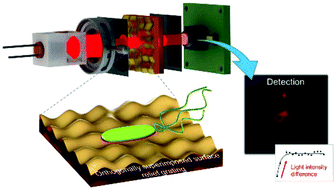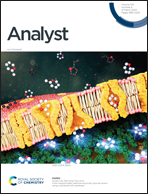Rapid label-free detection of intact pathogenic bacteria in situ via surface plasmon resonance imaging enabled by crossed surface relief gratings
Abstract
The unique plasmonic energy exchange occurring within metallic crossed surface relief gratings (CSRGs) has recently motivated their use as biosensors. However, CSRG-based biosensing has been limited to spectroscopic techniques, failing to harness their potential for integration with ubiquitous portable electronics. Here, we introduce biosensing via surface plasmon resonance imaging (SPRi) enabled by CSRGs. The SPRi platform is fully integrated including optics and electronics, has bulk sensitivity of 613 Pixel Intensity Unit (PIU)/Refractive Index Unit (RIU), a resolution of 10−6 RIU and a signal-to-noise ratio of ∼33 dB. Finite-Difference Time-Domain (FDTD) simulations confirm that CSRG-enabled SPRi is supported by an electric field intensity enhancement of ∼30 times, due to plasmon resonance at the metal-dielectric interface. In the context of real-world biosensing applications, we demonstrate the rapid (<35 min) and label-free detection of uropathogenic E. coli (UPEC) in PBS and human urine samples for concentrations ranging from 103 to 109 CFU mL−1. The detection limit of the platform is ∼100 CFU mL−1, three orders of magnitude lower than the clinical detection limit for diagnosis of urinary tract infection. This work presents a new avenue for CSRGs as SPRi-based biosensing platforms and their great potential for integration with portable electronics for applications requiring in situ detection.



 Please wait while we load your content...
Please wait while we load your content...